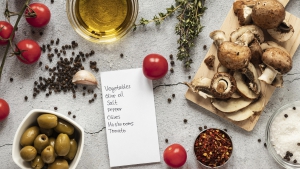Why Mushrooms Make the Perfect Gift for Christmas
With this year’s reunions set to be extra special, December is a wonderful time for catching up with our loved ones, swapping gifts, and indulging in feasts together. Of course, with all the celebrations, Christmas isn’t always a good time for our health (or the scales)!
We know that by simply adding mushrooms to our Christmas stuffing, to chip and dip platters for entertaining, and including mushrooms in summer BBQ recipes is a great way to serve lighter, healthier and tastier meals this festive season - but there are also very specific reasons why mushrooms are a great health gift to give your loved ones this Christmas.
White Mushroom Cups – The gift of vitamin D.
The white mushroom cup is on the top of our Christmas tree, as it is Australia’s most popular festive mushroom - with good reason. Despite its small size, exciting new Australian research1 has uncovered that this little mushroom is full of B group vitamins (including B12), minerals, antioxidants, and gut health nutrients. The research also confirmed something very exciting - mushrooms are the only wholefood able to provide 100% of the daily recommended dose of vitamin D per serve.
Presenting as an active hormone called ergosterol, mushrooms can produce vitamin D in a similar process to our skin. When mushrooms are exposed to sunlight for just 15-minutes the ergosterol converts into a bioactive form of vitamin D, which we absorb when we eat the mushroom. Amazingly, once a mushroom has been ‘supercharged’ with vitamin D by being exposed to the sun, the new D levels remain in the mushroom for up-to a week if they are stored in the fridge.
Please read the full article here.
Source: AMGA / Australian Mushroom Growers´ Assoc.
Reviewed by Emily Henderson, B.Sc.
Researchers have identified another good reason to eat more mushrooms. New research , published in Food Science & Nutrition (January 2021) found that adding a mushroom serving to the diet increased the intake of several micronutrients, including shortfall nutrients such as vitamin D, without any increase in calories, sodium or fat.
Dr. Victor L. Fulgoni III and Dr. Sanjiv Agarwal modeled the addition of mushrooms to National Health and Nutrition Examination Survey (NHANES) 20112016 dietary data looking at a composite of white, crimini and portabella mushrooms at a 1:1:1 ratio; one scenario including UVlight exposed mushrooms; and one scenario including oyster mushrooms for both 918 years and 19+ years of age based on an 84g or ½ cup equivalent serving.
Key findings include:
- Adding an 84g serving of mushrooms increased several shortfall nutrients including potassium and fiber. This was true for the white, crimini and portabella 1:1:1 mix and the oyster mushrooms.
- The addition of a serving (84 g) of mushrooms to the diet resulted in an increase in dietary fiber (5%6%), copper (24%32%), phosphorus (6%), potassium (12%14%), selenium (13%14%), zinc (5%6%),
riboflavin (13%15%), niacin (13%14%), and choline (5%6%) in both adolescents and adults; but had no impact on calories, carbohydrate, fat or sodium. - When commonly consumed mushrooms are exposed to UVlight to provide 5 mcg vitamin D per serving, vitamin D intake could meet and slightly exceed the recommended daily value (98% 104%) for both the 9 18 year and 19+ year groups as well as decrease inadequacy of this shortfall nutrient in the population.
- A serving of UVlight exposed commonly consumed mushrooms decreased population inadequacy for vitamin D from 95.3% to 52.8% for age group 918 years and from 94.9% to 63.6% for age group 19+ years.
"This research validated what we already knew that adding mushrooms to your plate is an effective way to reach the dietary goals identified by the DGA. Data from surveys such as NHANES are used to assess nutritional status and its association with health promotion and disease prevention and assist with formulation of national standards and public health policy (CDC, 2020)."
Mary Jo Feeney, MS, RD, FADA, Nutrition Research Coordinator,
Mushroom Council
Mushrooms are fungi a member of the third food kingdom biologically distinct from plant and animalderived foods that comprise the USDA food patterns yet have a unique nutrient profile that provides nutrients common to both plant and animal foods.
Although classified into food grouping systems by their use as a vegetable, mushrooms' increasing use in main entrees in plantforward diets is growing, supporting consumers' efforts to follow foodbased dietary guidance recommendations to lower intake of calories, saturated fatty acids, and sodium while increasing intake of underconsumed nutrients including fiber, potassium and vitamin D. Often grouped with vegetables, mushrooms provide many of the nutrient attributes of produce, as well as attributes more commonly found in meat, beans or grains.
According to the USDA's FoodData Central, 5 medium raw, white mushrooms (90g) contain 20 calories, 0g fat, 3g protein and are very low in sodium (0mg/<1% recommended daily value). Few foods naturally contain vitamin D, and mushrooms are unique in that they are the only food in the produce aisle that contain vitamin D. Specifically, one serving of raw, UVexposed, white (90g) and crimini (80g) mushrooms contains 23.6mcg (118% RDA) and 25.52mcg (128% RDA) of vitamin D, respectively.
Mushrooms are one of the best dietary sources of sulfurcontaining antioxidant amino acid ergothioneine and tripeptide glutathione Ergothioneine and glutathione contents in mushrooms depends upon the mushroom varieties, and oyster mushrooms contain more amounts of these sulfur containing antioxidants than commonly consumed mushrooms: white button, crimini, or portabella mushrooms. The addition of a serving of commonly consumed mushrooms and oyster mushrooms would be expected to add 2.24 and 24.0 mg ergothioneine, respectively, and 3.53 and 12.3 mg glutathione, respectively, to the NHANES 20112016 diets based on published literature values.
At this time, the USDA FoodData Central database does not include analytical data on ergothioneine. However, the Mushroom Council is currently supporting research to analyze mushrooms for bioactives/ergothioneine for possible inclusion in USDA FoodData Central database.
More research from the mushroom council still to come
With mushrooms growing in awareness and consideration among consumers nationwide, in 2019, the Mushroom Council made a $1.5 million multiyear investment in research to help broaden understanding of the food's nutritional qualities and overall health benefits.
In addition to the analysis of mushrooms for bioactives/ergothioneine for inclusion in USDA FoodData Central database, additional research projects approved include:
- Health promoting effects of including mushrooms as part of a healthy eating pattern.
- Mushrooms' relationship with cognitive health in older adults. Mushrooms' impact on brain health in an animal model.
- Nutritional impact of adding a serving of mushrooms to USDA Food Patterns.
Since 2002, the Council has conducted research that supports greater mushroom demand by discovering nutrient and health benefits of mushrooms. Published results from these projects form the basis for communicating these benefits to consumers and health influencers.
Source: FLM Harvest Journal






















